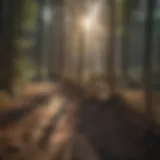Discovering the Ozarks Caves: An In-Depth Guide
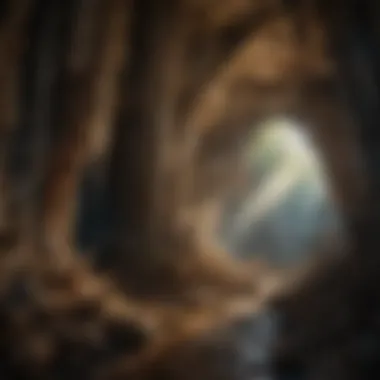

Intro
The Ozark region, stretching across Missouri, Arkansas, and parts of Oklahoma, is a treasure trove of natural wonders, known particularly for its extensive cave systems. The presence of these caves offers a glimpse into the geological past, crafting a fascinating narrative woven through time. The lush forests that blanket the Ozarks do more than just house these caves; they create an intricate tapestry of ecosystems that thrive together in an often fragile balance.
Within these deep, dark recesses lies a world that is both remarkable and fragile, where stunning rock formations tell the story of millions of years of geological evolution. Delving into these caves not only uncovers the splendor of nature but also illuminates the vital role they play in biodiversity, ecosystem services, and cultural history.
This guide serves as a framework for understanding the significant interplay between the caves and the surrounding woodlands, emphasizing the importance of conservation and responsible stewardship. Harnessing the insights gathered here, we aim to foster a deeper appreciation for these geological wonders while promoting sustainable practices among both local communities and visitors.
Preamble to the Ozarks Caves
The Ozarks are home to a rich tapestry of caves that hold much more than meets the eye. These hidden chambers, carved over millennia, represent a unique confluence of geological marvels and ecological significance. When considering the topic of Ozark caves, one must appreciate their vital role in local ecosystems, cultural narratives, and even economic activities. Exploring these caves offers not only a glimpse into nature’s artistry but also presents opportunities for conservation and education.
Understanding the depths of these caves is crucial, especially for those interested in forestry and ecological studies. These areas provide a window into the region’s intricate natural processes. In addition to offering unique recreational activities such as spelunking and hiking, the caves contribute to biodiversity as they house a variety of species adapted to peculiar subterranean environments.
"Caves are the unassuming sentinels of geological history, providing clues to Earth's past – a true treasure trove for the curious mind."
As we venture deeper into the Ozarks, we will explore the complex interrelationships between the terrain, the wildlife, and the communities that have both thrived by and protected these underground worlds. Recognizing the significance of these caves is paramount not only for current appreciation but also for future stewardship. Let's now delve into the geographical context of the Ozarks to better grasp the setting of these captivating caves.
Geographical Overview
The Ozarks, sprawling across parts of Arkansas, Missouri, and other nearby states, provide a diverse landscape that significantly influences the characteristics of its caves. The region is well-known for its rolling hills, clear streams, and, critically, its limestone bedrock, which forms the foundation for most cave systems. This unique geology is shaped by karst topography, where soluble rock dissolves over time, creating chambers and passageways ideal for cave formation.
Each cave in the Ozarks tells a story about the geological past of the area. For instance, the Missouri's Mark Twain Cave, renowned for its historical significance, connects to the broader cultural landscape of the Ozarks while also demonstrating the geological forces at play.
Some notable features of the geographical landscape include:
- Hills and Valleys: The Ozarks' elevation allows for varied microclimates, affecting both cave formation and biodiversity.
- Rivers and Streams: These flowing waters contribute to the cave systems' development, allowing for unique formations and habitats to thrive.
- Forest Coverage: Dense woodlands envelop many cave entrances, creating rich ecosystems that rely on both surface and subterranean environments.
Formation Processes
The formation of Ozark caves is a fascinating interplay of various geological processes. The primary driver of cave development in this region is the dissolution of limestone through a process known as chemical weathering. Rainwater, slightly acidic due to dissolved CO2, seeps into the ground, interacting with limestone and gradually carving out expansive caves. Over time, a network of caverns emerges, shaped by water flow, sediment deposits, and the structural weaknesses in the rock.
Several key processes can be identified:
- Erosion: This continuously reshapes the cave networks, removing debris and widening passageways.
- Stalactite and Stalagmite Formation: As mineral-rich water drips from the ceilings, formations develop over thousands of years, adding intricate features to caves like Marvel Cave.
- Collapse: In some cases, cave ceilings weaken and lead to sinkholes forming, which dramatically alters the cave's structure and accessibility.
This understanding of cave formation lays the groundwork for appreciating the biodiversity and cultural aspects that we will explore in later sections. Each cavern stands as an archive of age-old processes combining to create striking features that, while hidden from view, are essential to the ecosystem and local heritage.
Geological Features of Ozark Caves
Understanding the geological features of the Ozark caves is crucial for grasping the unique characteristics inherent to this region. The caves serve as more than just subterranean chambers; they are dynamic systems shaped by ancient geological processes that have left significant marks on the landscape. This section will delve into the intricacies of the geological formations that define the Ozark caves, focusing on the karst topography and unique rock formations that make them a point of interest for both researchers and visitors alike.
Karst Topography
Karst topography represents a landscape shaped by the dissolving action of water on soluble rocks, primarily limestone. This process creates various geological formations, including sinkholes, underground rivers, and, of course, caves. The Ozarks are a prime example of such a landscape, showcasing how natural processes sculpt the earth over millennia.
The karst features of the Ozarks are not merely eye-catching; they play a vital role in local ecology and hydrology. Here are some noteworthy aspects of oskars karst topography:
- Water Management: The drainage patterns in karst environments are unique. Rainwater infiltrates the ground quickly, filtering through layers of limestone, which aids in purifying the water before it enters the aquifers. This natural filtration system is invaluable for maintaining clean water sources.
- Biodiversity Niche: The varied microclimates created by different cave systems foster diverse habitats for various species. From unique plants to rare animals, karst zones support a range of life not found in flat terrains.
- Cultural Significance: Many of the caves in this area have long been viewed as sacred sites. Indigenous peoples utilized them for ceremonial purposes, and today, they still hold cultural narratives that deepen our understanding of the land.
Unique Rock Formations
The rock formations within Ozark caves tell a story of time and transformation. As layered sedimentary environments, the rock here offers instruments for understanding the geological history of North America. When you explore these caves, you encounter:
- Stalactites and Stalagmites: Formed by mineral-rich water dripping from the ceiling, these features take thousands of years to develop. Their growth causes one to reflect on the passage of time and the slow, yet powerful, forces of nature.
- Flowstone: Unlike stalactites and stalagmites, flowstone forms from water flowing over the cave surfaces. Its smooth, often wavy appearances create mesmerizing shapes that enhance the aesthetic quality of the caves.
- Fossil Imprints: Some caves display fossils embedded in the rock, providing clues about past climates and ecosystems. These imprints are like chapters in the Earth’s history book, telling stories of ancient marine life that once thrived in this region.
Overall, the geological features of Ozark caves not only enhance their allure but also serve critical ecological functions. They provide insights into the earth's history while also emphasizing the need for careful stewardship of these natural treasures. As the Ozarks continue to be explored, they reveal a deeper connection between geology and the myriad life forms it supports.
"Caves are not just holes in the ground; they are reservoirs of natural history and ecosystems that thrive in darkness."
Biodiversity in Ozark Caves
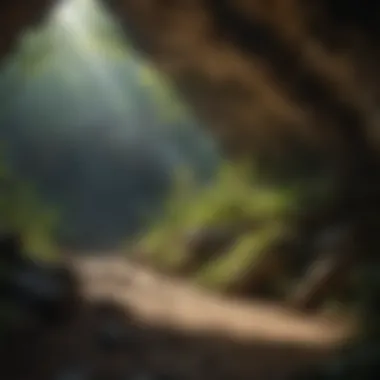

Biodiversity in Ozark caves is more than just a scientific classification; it represents a complex tapestry of life interwoven within the subterranean world. This biodiversity is crucial not only for maintaining the ecological balance of the region but also for providing insights into evolutionary processes and contributing to the health of broader ecosystems. The caves offer unique habitats that nurture diverse species of flora and fauna, each adapted to thrive in their shadowy environment.
Cave Fauna
The caves of the Ozarks house a remarkable assortment of creatures, each exhibiting specialized adaptations that allow them to survive in low-light environments. Among the most notable is the Ozark blind salamander, which thrives in these subterranean water systems. This species has evolved to have no eyes, a fascinating physiological change reflecting its long-term adaptation to cave life. There are also various species of bats, such as the tri-colored bat, which play an essential role in insect control and pollination.
The ecosystem found in these caves can be categorized into several groups, including:
- Troglobites: species that are fully adapted to life in the cave environment. These include diverse insects and crustaceans, such as the well-known cave isopod.
- Troglophiles: species that can live both inside and outside caves. An example is the cave cricket, which adds to the dynamic of cave life while depending on both realms for sustenance.
- Troglodytes: creatures that primarily dwell outside caves but may venture into them, like certain bird species that use cave entrances for roosting.
These creatures don't just contribute to biodiversity; they also serve as indicators of cave health. Changes in their populations can signal shifts in environmental conditions, thus playing a pivotal role in ecological monitoring.
Ecological Interactions
The interactions among species in the cave environment form a delicate web of life that showcases ecological dependencies. Predation, competition, and symbiosis are constant, influencing the survival of various species. For instance, without bats, the cave ecosystem would face an increase in insect populations, altering the food web significantly.
Furthermore, these cave ecosystems highlight critical nutrient cycling. Decomposers, such as fungi and bacteria, break down organic materials, recycling nutrients that sustain the subterranean food chain. This process underpins the vitality of the ecosystem, allowing primary producers like algae to flourish in inaccessible water bodies.
**"The interdependence of species in caves signifies the intricate balance required for maintaining ecological stability, showcasing evolution's magnificent artistry."
The link between cave fauna and their habitats is also indispensable for water quality. The caves influence groundwater recharge and filtration, showing again how biodiversity contributes to broader ecosystem services. Keeping these cave systems thriving means maintaining the species that depend on them, thus promoting healthy ecosystems beyond the cave itself.
Cultural and Historical Significance
Understanding the cultural and historical significance of the Ozark caves goes beyond mere geological features. These caves are repositories of the dreams, struggles, and lives of those who've walked the earth before us. From indigenous tribes who sought refuge and sacred space to early settlers carving a life in these wild regions, the caves have played crucial roles in shaping human experience. Their historical narratives not only enhance our understanding but also reinforce a sense of collective identity among local communities.
Indigenous Peoples and Caves
The relationship between indigenous peoples and the Ozark caves is a tapestry woven into the landscape. While carved by natural processes, these caves hold spiritual significance. Various tribes, including the Osage and the Quapaw, utilized these hollows for various purposes. They sought shelter from fierce storms, gathered for spiritual rituals, and preserved artifacts that hold tales of their ancestors.
Some research indicates that certain caves were considered sacred grounds. The stalactites, for example, could symbolize the connection between earth and sky, representing the duality of existence. In a recent discovery, an indigenous storytelling cave reached the spotlight, where murals etched on the walls told stories of creation and harmony with nature, highlighting their rich cultural narratives.
Key Points
- The caves served as historical landmarks for navigation and survival by early native peoples.
- Spiritual practices centered on these caves marked them as sacred spaces.
- Rock art has provided insights into the cultural values and beliefs of past societies.
Conservation Challenges and Initiatives
Conservation challenges in the context of the Ozarks caves represent a critical intersection of natural history, ecological health, and community engagement. These dark, cool caverns are more than just geological curiosities; they serve as vital ecosystems that support unique flora and fauna, while also being pivotal to the local cultural history. Consequently, understanding the various threats to these systems is foundational for developing effective initiatives aimed at safeguarding them.
Threats to Cave Ecosystems
The delicate balance within cave ecosystems is increasingly being disrupted by a number of external pressures. Some of the most pressing threats include:
- Pollution: Contaminants from agricultural runoff and urban development often percolate into the cave systems through groundwater. Such pollution can alter the organic composition, impacting cave-dwelling species.
- Climate Change: Alterations in temperature and moisture patterns can directly impact the microclimates of caves. Species adapted to certain conditions may find themselves in less hospitable environments.
- Human Activity: Activities like tourism can lead to physical disturbances and habitat degradation. The more people wander into caves without proper guidelines, the higher the risk of damaging fragile formations and disturbing wildlife.
- Invasive Species: Non-native species can outcompete indigenous cave-dwelling organisms for resources, creating significant shifts in the ecological balance.
- Resource Extraction: Mining and other natural resource extraction activities pose direct physical threats to cave structures and the surrounding ecosystems, potentially leading to long-term irreparable damage.
"The health of cave ecosystems is an indicator of the overall ecological integrity of the regions in which they reside. Protecting them can signal a broader commitment to ecological stewardship."
Conservation Strategies
In light of these challenges, numerous conservation strategies have been adopted or proposed, aimed at preserving these critical ecosystems. Here are key actions being undertaken:
- Legal Protections: Establishing legal frameworks that designate caves as protected areas can create a buffer against development and degradation. Laws focusing on habitat protection can ensure these vital spaces remain untouched.
- Education and Awareness: Engaging local communities through education about the importance of caves fosters a stewardship mentality. Programs tailored to schools, local residents, and visitors can effectively raise awareness regarding best practices in cave visitation and preservation.
- Ecological Monitoring: Implementing systematic monitoring of cave conditions and species populations helps in identifying changes over time, allowing for informed, timely intervention strategies to be developed.
- Community Involvement: Encouraging local inhabitants to actively participate in conservation efforts not only empowers them but also ensures that those most familiar with the land have a voice in preservation strategies. Community-led initiatives can foster a deeper connection between residents and their natural heritage.
- Research Collaborations: Partnering with academic institutions for research can yield valuable insights into cave ecosystems and potential threats, leading to more effective outreach and conservation campaigns.
Recreational Opportunities in the Ozarks
Exploring the Ozarks isn't just about marveling at the geological wonders of the caves. It's also about the recreational options that these natural formations offer. The Ozarks are a natural playground for many outdoor enthusiasts. There’s a smorgasbord of activities that not only provide enjoyment but also foster a deeper appreciation for these unique ecosystems.
These recreational opportunities play a significant role in enlightening visitors. They help them see the balance between nature and human interaction, which is crucial for conservation. By participating in these activities, people become not just spectators of the wilderness but active participants in its preservation.
Cave Tours and Exploration
Cave tours in the Ozarks are a bucket-list experience for any adventure seeker. You can visit well-known caves like Marvel Cave or the fantastic Onyx Cave, each offering a plethora of guided tours. These tours range from easy strolls through well-lit paths to more rugged explorations requiring climbing gear. Each tour unpacks the stories hidden within the cave walls, such as the intricate formations shaped by thousands of years of geological processes.
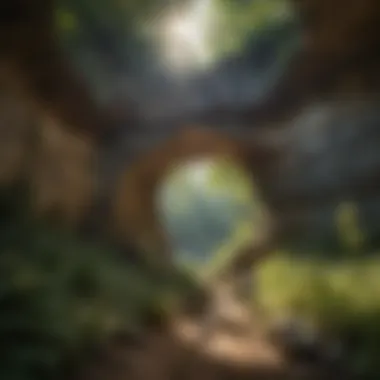

During these tours, guides share their knowledge about the local geology, ecology, and the historical significance of these caves. As you walk through the damp air, you might catch a glimpse of mineral deposits and unique stalactites and stalagmites, sparking a sense of awe. It’s not just about enjoying the view; you gain insight into the delicate balance of cave ecosystems.
"Caves are not just voids in the ground; they're vibrant ecosystems and cultural touchstones, woven intricately into the regional tapestry."
Moreover, many tour operators have started to emphasize sustainability, ensuring that their activities do not disturb the natural habitats within the caves. This mindful approach significantly enhances the overall experience, leaving the visitors not only entertained but also informed about conservation efforts.
Camping and Hiking in the Region
For those who prefer to take their adventures above ground, the Ozarks present an array of camping and hiking options. The region hosts several campgrounds that allow visitors to immerse themselves in nature’s bounty. Campgrounds such as the Ozark National Scenic Riverways provide access to serene riverside spots, perfect for camping amidst the sounds of chirping birds and rustling leaves.
Hiking trails also wind their way through the surrounding forests, showcasing the rich biodiversity of the Ozark region. Trails like the Ozark Highlands Trail challenge hikers with varied terrains but reward them with stunning vistas and encounters with local wildlife. Hiking not only enhances physical well-being but also provides an excellent opportunity for personal reflection and a connection with nature.
Visitors should consider a few best practices for camping and hiking:
- Leave No Trace: Respect the environment by cleaning up after yourself.
- Wildlife Awareness: Understand how to coexist peacefully with local animals, ensuring safety for both humans and wildlife.
- Stay on Designated Trails: Protect the delicate ecosystem by sticking to marked paths.
In summary, the recreational opportunities in the Ozarks are not merely about thrill-seeking; they play a vital part in education and conservation. Whether through cave explorations or hiking adventures, these activities foster greater appreciation and respect for the natural world, making them essential experiences for anyone venturing into this beautiful region.
Ecological Importance of Caves
The role of caves in an ecosystem is often overlooked, yet they serve as crucial components in maintaining environmental balance. Caves hold a unique habitat that supports numerous species and provides essential resources, impacting both local wildlife and human communities. Understanding the ecological significance of caves offers valuable insights into our natural world and highlights the need for responsible management and conservation efforts.
Water Filtration and Conservation
Caves act as natural filters, playing a vital role in water conservation. They collect and store groundwater, which is essential for both wildlife and human use. As rainwater seeps through soil and rock layers before entering cave systems, it is purified by the natural filtration processes. This leads to cleaner water reaching aquifers, ensuring safe drinking water for human populations. Additionally, the presence of caves can regulate water levels in surrounding areas, aiding in flood prevention and water supply stability. The interaction of water with rock formations also creates unique mineral compositions, contributing to the ecological diversity of the area.
"Caves not only serve as a home for many species but also play a crucial role in the water cycle, ensuring quality water reaches our communities."
Biodiversity Hotspots
Ozark caves serve as biodiversity hotspots. They provide habitats for specialized species like bats, cave-dwelling insects, and unique flora that have adapted to the dark and humid conditions. These organisms not only rely on caves for shelter but also play significant roles in various ecological processes. For instance, bats help in pest control and pollination while also contributing to nutrient cycling through their guano.
Moreover, caves can help support populations of endangered or vulnerable species, serving as refuges during environmental changes. As ecosystems undergo shifts due to climate change, caves may provide critical environments for species survival. The cave-dwelling organisms often have limited distribution, making their conservation paramount. Protecting these unique habitats is essential not just for the species within them, but also for maintaining ecological balance and biodiversity in surrounding regions.
The symbiotic relationships between cave organisms and their environments highlight the interconnectedness of ecosystems. Therefore, acknowledging the ecological importance of caves is crucial for fostering long-term conservation strategies that benefit both local wildlife and human communities.
The Role of Community in Cave Preservation
The preservation of Ozark caves is intricately linked with the local community's involvement and commitment. When residents and stakeholders take the initiative to protect these natural wonders, the chances of maintaining their ecological and cultural significance increase significantly. This section delves into the critical role local communities play in advocating for cave preservation and highlights the direct benefits derived from their participation.
Local Involvement and Advocacy
Community engagement often starts with local groups and organizations that aim to raise awareness about the caves' importance. Here, advocacy for sustainable practices gathers momentum as people recognize the caves as not just geological formations but as essential components of their cultural identity and local economy. The people of the Ozarks often hold a deep-rooted connection to these caves, which dates back generations.
- Many of these local groups develop campaigns targeting specific issues like littering, pollution, or the impact of illegal activities on cave ecosystems.
- These advocacy efforts can result in implementing laws or regulations effectively combating these threats.
In some cases, community members organize clean-up days or guided tours that educate others while promoting respect for the environment. It is this grassroots effort that sets the stage for broader conservation strategies. Moreover, as residents see the tangible consequences of their actions, they often become more passionate about preserving these caves for future generations.
Educational Programs and Outreach
Education is another pivotal aspect of community efforts in cave preservation. Informational programs targeting schools, local businesses, and recreational clubs help foster an appreciation for the Ozark caves. These initiatives can range from simple presentations to in-depth workshops.
- Workshops provide hands-on experiences, allowing participants to explore cave systems responsibly while learning about the unique ecosystems inside.
- Some local colleges partner with conservation organizations to develop curriculums that focus on ecological restoration, equipping students with necessary tools for sustainable practices.
Often, outreach programs aim to involve children and young adults. By engaging the youth, these programs instill a sense of stewardship that often carries through into adulthood, creating a cycle of conservation-minded individuals.
"The caves have stories to tell. It’s our duty to listen and protect them for those who come after us."
Ultimately, through educational outreach, communities cultivate a culture that recognizes the caves as invaluable heritage sites deserving of protection.
In summary, the success of cave preservation relies heavily on community involvement. Whether through advocacy or educational programs, it is the people of the Ozarks who breathe life into preservation efforts, ensuring these caves continue to thrive amidst evolving environmental challenges.
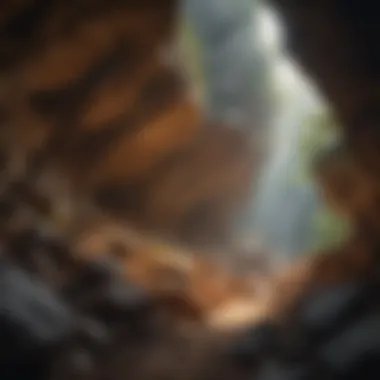

Technological Advances in Cave Research
Technological advances play a pivotal role in enhancing our understanding of the Ozarks caves. These innovations not only provide new insights into the geological and ecological aspects of these caves but also aid in conservation efforts. With sophisticated tools and methods at their disposal, researchers and conservationists alike can better document, monitor, and preserve these vital natural resources. The integration of technology has turned what was once a purely exploratory endeavor into a precise scientific study.
Mapping and Documentation Techniques
The implementation of cutting-edge mapping and documentation techniques has revolutionized cave research. Laser scanning and 3D modeling are at the forefront, enabling researchers to create highly precise digital representations of cave systems. These maps allow for a detailed understanding of the cave's structure and layout, aiding in studies related to hydrology, geology, and cave ecology.
Additionally, Geographic Information System (GIS) technology allows researchers to overlay various data sets. For instance, one might combine geological maps with biodiversity surveys, which reveals patterns that otherwise might remain hidden. The benefits are twofold: researchers gain a comprehensive perspective on the cave's ecological role and its response to environmental changes.
Key benefits of these mapping techniques include:
- Enhanced Data Accuracy: Traditional methods have limitations in precision. New technologies minimize human error.
- Improved Accessibility: Digital maps can be shared globally, fostering collaboration among scientists and conservationists.
- Longitudinal Studies: Regular updates to these maps facilitate monitoring changes over time, crucial for conservation efforts.
"Mapping the unseen — today’s technological tools bring light to the depths that were once shrouded in darkness."
Environmental Monitoring Tools
Accompanying the advancements in mapping, environmental monitoring tools have become indispensable in cave research. These instruments allow for the ongoing assessment of various environmental parameters within the cave systems, including humidity levels, temperature fluctuations, and water quality.
For example, automated sensors can continuously track air and water conditions, providing real-time data that is invaluable for researchers. This proactive approach offers several notable advantages:
- Early Detection of Changes: Continuous monitoring can alert researchers to distress signals in the cave ecosystem, such as pollution or temperature spikes that could impact biodiversity.
- Data-Driven Decisions: Armed with precise data, conservation strategies can be tailored to address specific issues rather than relying on generalized approaches.
- Enhanced Research Collaboration: These tools facilitate partnerships across disciplines as ecologists, geologists, and environmental scientists can merge their findings to gain a holistic view of the cave ecosystems.
The future of cave research is heavily leaning on technology, and as we immerse ourselves deeper into the Ozarks, the tools and techniques used to study these caves reflect a significant leap forward in our exploration and conservation strategies. As prospects broaden, the balance between human activity and the preservation of these natural wonders will remain a critical focal point for both current and future research.
Future Outlook for Ozarks Caves
The future of the Ozarks caves is a multifaceted topic that extends beyond mere exploration. It brings together the urgent matters of conservation, scientific research, and community involvement. Given the ongoing threats posed by environmental changes, human activities, and even tourism's impact, understanding the future of these caves is crucial. As we step further into this discussion, one must see the caves as not just places of curiosity, but as vital ecosystems that need protection and thoughtful management.
Long-term Conservation Goals
Long-term conservation goals are essential for ensuring the survival of the Ozark caves and their unique ecosystems. These goals serve as a roadmap for preserving not only the caves themselves but also the flora and fauna that thrive within them.
- Habitat Preservation: It is vital to protect the natural habitats surrounding the caves. In doing so, we maintain the ecological balance that exists in these environments. Initiatives that focus on reforestation and minimizing land development can be effective.
- Monitoring Diverse Species: Many species found in the Ozarks caves are not only unique but also vulnerable. Therefore, establishing monitoring programs to continuously check on the health of these populations ensures that any distress signals are responded to promptly.
- Education and Awareness: Raising awareness about the ecological significance of these caves among local communities can lead to more sustainable practices. Workshops and educational programs in schools could encourage upcoming generations to appreciate and advocate for cave protection.
- Collaborative Efforts: Collaboration between government agencies, local organizations, and researchers can enhance resources for conservation efforts. Grants and funds can be directed toward preserving these natural wonders by combining expertise from different sectors.
"Preserving the Ozark caves is not just about conservation; it's about safeguarding a legacy for future generations to explore and learn from."
Research and Development Directions
Looking ahead, research and development directions must evolve to keep pace with changing environmental conditions and technological advancements. This phase is less about what we know and more about what we need to discover.
- Advanced Mapping Techniques: Researchers are employing cutting-edge technologies, such as LiDAR (Light Detection and Ranging), to create detailed maps of cave systems. This aids in understanding their complexities and planning conservation strategies.
- Climate Change Research: Investigating how climate fluctuations are affecting cave environments should be a priority. This includes understanding shifts in water flow, temperature, and humidity levels which can drastically impact cave ecosystems.
- Microbial Studies: The unique microbiomes found in caves hold potential for breakthroughs in biotechnology and medicine. Continued research can uncover new applications for these microorganisms, paving the way for innovations in various fields.
- Public Database: Establishing a comprehensive database that catalogs all research conducted in Ozark caves could facilitate better understanding and networking among researchers. This could enhance collaborative efforts and centralize important information.
In summary, the future outlook for Ozarks caves hinges significantly on thoughtful conservation goals combined with dynamic research strategies. These initiatives promise not only to safeguard the caves but also to enrich our understanding of these unique geological wonders.
Final Thoughts
When considering the awe-inspiring caves of the Ozarks, one must reflect on their multifaceted significance. These caves are not just natural wonders; they serve as a vital connection between the past and the future. Understanding their importance helps in fostering a sense of responsibility towards stewardship. They are crucial environments that support various forms of life, unique geological formations, and cultural heritage. Protecting these caves goes beyond mere preservation; it involves recognizing them as integral components of our ecosystem.
"The health of our caves is reflective of the health of our land and community."
The Importance of Stewardship
Stewardship isn't simply about managing resources; it's about cultivating a deep respect for nature. In the context of Ozark caves, stewardship manifests in various practical ways. It emphasizes sustainable practices that ensure these unique environments are preserved for future generations. Here are some key aspects of why stewardship is imperative:
- Ecosystem Balance: The caves play a role in regulating local ecosystems, providing habitats to a myriad of species. When individuals engage in responsible stewardship, they help maintain the delicate balance necessary for these ecosystems to thrive.
- Cultural Heritage: Many caves contain artifacts from indigenous populations and reflect a long history of human interaction with the land. Upholding stewardship means protecting these cultural treasures from vandalism and neglect.
- Educational Opportunities: Promoting responsible exploration and understanding of caves helps in environmental education. Communities can benefit from learning about the importance of these caves in their local ecology.
Stewardship encourages an appreciation for nature that can lead to a more sustainable future. Those who engage in these practices become better ambassadors for conservation and guardians of the land.
Engaging Future Generations
To ensure the survival of the Ozark caves, it's essential to engage the youth. Connecting young people with their local environment fosters a sense of ownership and responsibility. Here’s how we can facilitate this engagement:
- Educational Programs: Schools and organizations can develop programs that focus on the caves, teaching students about their ecological and cultural significance. Field trips can provide first-hand experience and foster a love for the natural world.
- Volunteer Opportunities: Involving youths in conservation projects can instill a strong connection to the land. By participating in clean-up efforts or guided cave tours, young individuals can directly contribute to their preservation.
- Interactive Platforms: Utilizing social media and digital tools can help expose younger audiences to the wonders of the Ozarks. Sharing stories, facts, or beautiful images of the caves can spark curiosity and interest.
The future of these caves largely depends on how effectively we can spark the passion of the next generation. Engaging them in meaningful ways ensures that they not only appreciate the beauty of the Ozarks but also become advocates for their preservation.
In summary, understanding and emphasizing the significance of stewardship and the involvement of future generations can create a foundation that supports the ongoing protection of the Ozarks caves. Their stories, ecosystems, and history are worth preserving, and it starts with the commitment we all share to engage, educate, and protect.


